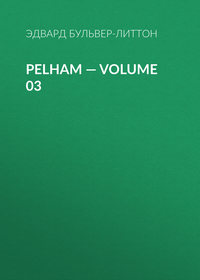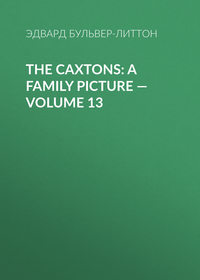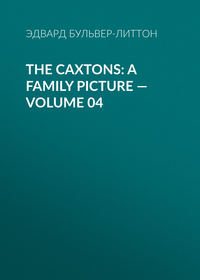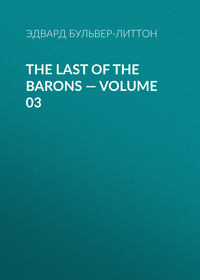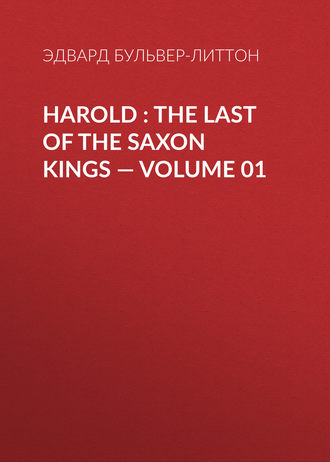
Harold : the Last of the Saxon Kings — Volume 01
The story of Osgood and Ailred, the childemaister (schoolmaster in the monastery), as related by Palgrave, and used in this romance, is recorded in a MS. of Waltham Abbey, and was written somewhere about fifty or sixty years after the event—say at the beginning of the twelfth century. These two monks followed Harold to the field, placed themselves so as to watch its results, offered ten marks for the body, obtained permission for the search, and could not recognise the mutilated corpse until Osgood sought and returned with Edith. In point of fact, according to this authority, it must have been two or three days after the battle before the discovery was made.
1
Sismondi's History of France, vol. iv. p. 484.
2
"Men's blinded hopes, diseases, toil, and prayer, And winged troubles peopling daily air."3
Merely upon the obscure MS. of the Waltham Monastery; yet, such is the ignorance of popular criticism, that I have been as much attacked for the license I have taken with the legendary connection between Harold and Edith, as if that connection were a proven and authenticated fact! Again, the pure attachment to which, in the romance, the loves of Edith and Harold are confined, has been alleged to be a sort of moral anachronism,—a sentiment wholly modern; whereas, on the contrary, an attachment so pure was infinitely more common in that day than in this, and made one of the most striking characteristics of the eleventh century; indeed of all the earlier ages, in the Christian era, most subjected to monastic influences.
4
Notes less immediately necessary to the context, or too long not to interfere with the current of the narrative, are thrown to the end of the work.
5
There is a legend attached to my friend's house, that on certain nights in the year, Eric the Saxon winds his horn at the door, and, in forma spectri, serves his notice of ejectment.
6
The "Edinburgh Review," No. CLXXIX. January, 1849. Art. I. "Correspondance inedite, de Mabillon et de Montfaucon, avec l'Italie." Par M. Valery. Paris, 1848.
7
And long before the date of the travesty known to us, and most popular amongst our mediaeval ancestors, it might be shown that some rude notion of Homer's fable and personages had crept into the North.
8
"The apartment in which the Anglo-Saxon women lived, was called Gynecium."—FOSBROOKE, vol. ii., p. 570.
9
Glass, introduced about the time of Bede, was more common then in the houses of the wealthy, whether for vessels or windows, than in the much later age of the gorgeous Plantagenets. Alfred, in one of his poems, introduces glass as a familiar illustration:
"So oft the mild sea With south wind As grey glass clear Becomes grimly troubled." SHAR. TURNER.10
Skulda, the Norna, or Fate, that presided over the future.
11
The historians of our literature have not done justice to the great influence which the poetry of the Danes has had upon our early national muse. I have little doubt but that to that source may be traced the minstrelsy of our borders, and the Scottish Lowlands; while, even in the central counties, the example and exertions of Canute must have had considerable effect on the taste and spirit of our Scops. That great prince afforded the amplest encouragement to Scandinavian poetry, and Olaus names eight Danish poets, who flourished at his court.
12
"By the splendour of God."
13
See Note (A) at the end of this volume.
14
It is noticeable that the Norman dukes did not call themselves Counts or Dukes of Normandy, but of the Normans; and the first Anglo- Norman kings, till Richard the First, styled themselves Kings of the English, not of England. In both Saxon and Norman chronicles, William usually bears the title of Count (Comes), but in this tale he will be generally called Duke, as a title more familiar to us.
15
The few expressions borrowed occasionally from the Romance tongue, to give individuality to the speaker, will generally be translated into modern French; for the same reason as Saxon is rendered into modern English, viz., that the words may be intelligible to the reader.
16
"Roman de Rou," part i., v. 1914.
17
The reason why the Normans lost their old names is to be found in their conversion to Christianity. They were baptised; and Franks, as their godfathers, gave them new appellations. Thus, Charles the Simple insists that Rolf-ganger shall change his law (creed) and his name, and Rolf or Rou is christened Robert. A few of those who retained Scandinavian names at the time of the Conquest will be cited hereafter.
18
Thus in 991, about a century after the first settlement, the Danes of East Anglia gave the only efficient resistance to the host of the Vikings under Justin and Gurthmund; and Brithnoth, celebrated by the Saxon poet, as a Saxon par excellence, the heroic defender of his native soil, was, in all probability, of Danish descent. Mr. Laing, in his preface to his translation of the Heimskringla, truly observes, "that the rebellions against William the Conqueror, and his successors, appear to have been almost always raised, or mainly supported, in the counties of recent Danish descent, not in those peopled by the old Anglo-Saxon race."
The portion of Mercia, consisting of the burghs of Lancaster, Lincoln, Nottingham, Stamford, and Derby, became a Danish state in A.D. 877;— East Anglia, consisting of Cambridge, Suffolk, Norfolk, and the Isle of Ely, in A.D. 879-80; and the vast territory of Northumbria, extending all north the Humber, into all that part of Scotland south of the Frith, in A.D. 876.—See PALGRAVE'S Commonwealth. But besides their more allotted settlements, the Danes were interspersed as landowners all over England.
19
Bromton Chron—via., Essex, Middlesex, Suffolk, Norfolk, Herts, Cambridgeshire, Hants, Lincoln, Notts, Derby, Northampton, Leicestershire, Bucks, Beds, and the vast territory called Northumbria.
20
PALGRAVE's History of England, p. 315.
21
The laws collected by Edward the Confessor, and in later times so often and so fondly referred to, contained many introduced by the Danes, which had grown popular with the Saxon people. Much which we ascribe to the Norman Conqueror, pre-existed in the Anglo-Danish, and may be found both in Normandy, and parts of Scandinavia, to this day. —See HAKEWELL's Treatise on the Antiquity of Laws in this Island, in HEARNE's Curious Discourses.
22
PALGRAVE's History of England, p. 322.
23
The name of this god is spelt Odin, when referred to as the object of Scandinavian worship; Woden, when applied directly to the deity of the Saxons.
24
See Note (B), at the end of the volume.
25
The Peregrine hawk built on the rocks of Llandudno, and this breed was celebrated, even to the days of Elizabeth. Burleigh thanks one of the Mostyns for a cast of hawks from Llandudno.
26
Hlaf, loaf,—Hlaford, lord, giver of bread; Hleafdian, lady, server of bread.—VERSTEGAN.
27
Bedden-ale. When any man was set up in his estate by the contributions of his friends, those friends were bid to a feast, and the ale so drunk was called the bedden-ale, from bedden, to pray, or to bid. (See BRAND's Pop. Autiq.)
28
Herleve (Arlotta), William's mother, married Herluin de Conteville, after the death of Duke Robert, and had by him two sons, Robert, Count of Mortain, and Odo, Bishop of Bayeux.-ORD. VITAL. lib. vii.
29
Mone, monk.
30
STRUTT's Horda.
31
There is an animated description of this "Battle of London Bridge, "which gave ample theme to the Scandinavian scalds, in Snorro Sturleson:
"London Bridge is broken down; Gold is won and bright renown; Shields resounding, War-horns sounding, Hildur shouting in the din, Arrows singing, Mail-coats ringing, Odin makes our Olaf win." LAING's Heimskringla, vol. ii. p. 10.32
Sharon Turner.
33
Hawkins, vol. ii. p. 94.
34
Doomsday makes mention of the Moors, and the Germans (the Emperor's merchants) that were sojourners or settlers in London. The Saracens at that time were among the great merchants of the world; Marseilles, Arles, Avignon, Montpellier, Toulouse, were the wonted stapes of their active traders. What civilisers, what teachers they were—those same Saracens! How much in arms and in arts we owe them! Fathers of the Provencal poetry they, far more than even the Scandinavian scalds, have influenced the literature of Christian Europe. The most ancient chronicle of the Cid was written in Arabic, a little before the Cid's death, by two of his pages, who were Mnssulmans. The medical science of the Moors for six centuries enlightened Europe, and their metaphysics were adopted in nearly all the Christian universities.
35
Billingsgate. See Note (C), at the end of the volume.
36
London received a charter from William at the instigation of the Norman Bishop of London; but it probably only confirmed the previous municipal constitution, since it says briefly, "I grant you all to be as law-worthy as ye were in the days of King Edward." The rapid increase, however, of the commercial prosperity and political importance of London after the Conquest, is attested in many chronicles, and becomes strikingly evident even on the surface of history.
37
There seems good reason for believing that a keep did stand where the Tower stands, before the Conquest, and that William's edifice spared some of its remains. In the very interesting letter from John Bayford relating to the city of London (Lel. Collect. lviii.), the writer, a thorough master of his subject, states that "the Romans made a public military way, that of Watling Street, from the Tower to Ludgate, in a straight line, at the end of which they built stations or citadels, one of which was where the White Tower now stands." Bayford adds that "when the White Tower was fitted up for the reception of records, there remained many Saxon inscriptions."
38
Rude-lane. Lad-lane.—BAYFORD.
39
Fitzstephen.
40
Camden.
41
BAYFORD, Leland's Collectanea, p. lviii.
42
Ludgate (Leod-gate).—VERSTEGAN.
43
See Note (D), at the end of the volume.
44
Massere, merchant, mercer.
45
Fitzstephen.
46
Meuse. Apparently rather a hawk hospital, from Muta (Camden). Du Fresne, in his Glossary, says, Muta is in French Le Meue, and a disease to which the hawk was subject on changing its feathers.
47
Scotland-yard.—STRYPE.
48
The first bridge that connected Thorney Isle with the mainland is said to have been built by Matilda, wife of Henry I.
49
We give him that title, which this Norman noble generally bears in the Chronicles, though Palgrave observes that he is rather to be styled Earl of the Magesetan (the Welch Marches).
50
Eadigan.—S. TURNER, vol. i. p. 274.
51
The comparative wealth of London was indeed considerable. When, in 1018, all the rest of England was taxed to an amount considered stupendous, viz., 71,000 Saxon pounds, London contributed 11,000 pounds besides.
52
Complin. the second vespers.
53
Thomson's Essay on Magna Charta.
54
Orderic. Vital. lib. 4.
55
The date of William's marriage has been variously stated in English and Norman history, but is usually fixed in 1051-2. M. Pluquet, however, in a note to his edition of the "Roman de Rou," says that the only authority for the date of that marriage is in the Chronicle of Tours, and it is there referred to 1053. It would seem that the Papal excommunication was not actually taken off till 1059; nor the formal dispensation for the marriage granted till 1063.
56
For authorities for the above sketch, and for many interesting details of Lanfranc's character, see Orderic. Vital. Hen. de Knyghton, lib. ii. Gervasius; and the life of Lanfranc, to be found in the collection of his Works, etc.
57
Pigott's Scand. Mythol. p. 380. Half. Vand. Saga.
58
"Suthsaxonum Ministrum Wolfnothem." Flor. Wig.
59
Asser. de Reb. Gest. Alf. pp. 17, 18.
60
Camden, Caernarvonshire.
61
Pennant's Wales, vol. ii. p. 146.
62
The ruins still extant are much diminished since the time even of Pownall or Pennant; and must be indeed inconsiderable, compared with the buildings or walls which existed at the date of my tale.
63
Johann. ap. Acad. Celt. tom. iii. p. 151.
64
William of Poitiers.
65
He is considered to refer to such bequest in one of his charters: "Devicto Harlodo rege cum suis complicibus qui michi regnum prudentia Domini destinatum, et beneficio concessionis Domini et cognati mei gloriosi regis Edwardi concessum conati sunt auferre."— FORESTINA, A. 3.
But William's word is certainly not to be taken, for he never scrupled to break it; and even in these words he does not state that it was left him by Edward's will, but destined and given to him—words founded, perhaps, solely on the promise referred to, before Edward came to the throne, corroborated by some messages in the earlier years of his reign, through the Norman Archbishop of Canterbury, who seems to have been a notable intriguer to that end.
66
Palgrave, "Commonwealth," 560.
67
"Quo tumulato, subregulus Haroldus Godwin Ducis filius, quem rex ante suam decessionem regni successorem elegerat, a totius Angliae primatibus, ad regale culmen electus, die eodem ab Aldredo Eboracensi Archiepiscopo in regem est honorifice consecratus."—FLOR. Wig.
68
Some of these Norman chroniclers tell an absurd story of Harold's seizing the crown from the hand of the bishop, and putting it himself on his head. The Bayeux Tapestry, which is William's most connected apology for his claim, shows no such violence; but Harold is represented as crowned very peaceably. With more art, (as I have observed elsewhere,) the Tapestry represents Stigand as crowning him instead of Alred; Stigand being at that time under the Pope's interdict.
69
Edward died Jan. 5th. Harold's coronation is said to have taken place Jan. the 12th; but there is no very satisfactory evidence as to the precise day; indeed some writers would imply that he was crowned the day after Edward's death, which is scarcely possible.
70
Vit. Harold. Chron. Ang. Norm.
71
This William Mallet was the father of Robert Mallet, founder of the Priory of Eye, in Suffolk (a branch of the House of Mallet de Graville).—PLUQUET. He was also the ancestor of the great William Mallet (or Malet, as the old Scandinavian name was now corruptly spelt), one of the illustrious twenty-five "conservators" of Magna Charta. The family is still extant; and I have to apologise to Sir Alexander Malet, Bart. (Her Majesty's Minister at Stutgard), Lieut.- Col. Charles St. Lo Malet, the Rev. William Windham Malet (Vicar of Ardley), and other members of that ancient House, for the liberty taken with the name of their gallant forefather.


